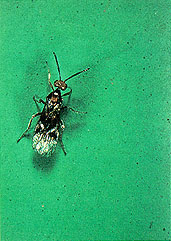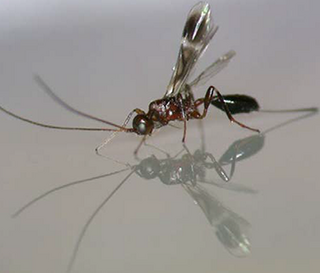Related Research Articles

Biological control or biocontrol is a method of controlling pests, whether pest animals such as insects and mites, weeds, or pathogens affecting animals or plants by using other organisms. It relies on predation, parasitism, herbivory, or other natural mechanisms, but typically also involves an active human management role. It can be an important component of integrated pest management (IPM) programs.

The blue willow beetle, formerly Phyllodecta vulgatissima, is a herbivourous beetle of the family Chrysomelidae. It is dark with a metallic sheen that ranges from a blue color to bronze. It is distinguished from P. vitellinae by the latter more commonly displaying bronze coloration. European Phratora species can be distinguished based on morphology of female genitalia. The larvae undergo three instar stages from hatching to pupation. This beetle is found throughout Europe and Scandinavia, and occurs in China.

The Braconidae are a family of parasitoid wasps. After the closely related Ichneumonidae, braconids make up the second-largest family in the order Hymenoptera, with about 17,000 recognized species and many thousands more undescribed. One analysis estimated a total between 30,000 and 50,000, and another provided a narrower estimate between 42,000 and 43,000 species.

Parasitoid wasps are a large group of hymenopteran superfamilies, with all but the wood wasps (Orussoidea) being in the wasp-waisted Apocrita. As parasitoids, they lay their eggs on or in the bodies of other arthropods, sooner or later causing the death of these hosts. Different species specialise in hosts from different insect orders, most often Lepidoptera, though some select beetles, flies, or bugs; the spider wasps (Pompilidae) exclusively attack spiders.

Habrobracon hebetor is a minute wasp of the family Braconidae that is an ectoparasitoid of several species of moth caterpillars. Well known hosts include the larval stage of Plodia interpunctella, the Indianmeal moth, the late larval stage of the Mediterranean flour moth and the almond moth, and the dried fruit moth. This parasitoid has been used commercially as a way to control pests without using chemical insecticides.

Glyptapanteles is a genus of endoparasitoid wasps found in all continents, except Antarctica. The larvae of Glyptapanteles species are able to manipulate their hosts into serving as bodyguards.

The Aphidiinae are a subfamily of tiny parasitoid wasps that use aphids as their hosts. Several species have been used in biological control programs of various aphids.

A wasp is any insect of the narrow-waisted suborder Apocrita of the order Hymenoptera which is neither a bee nor an ant; this excludes the broad-waisted sawflies (Symphyta), which look somewhat like wasps, but are in a separate suborder. The wasps do not constitute a clade, a complete natural group with a single ancestor, as bees and ants are deeply nested within the wasps, having evolved from wasp ancestors. Wasps that are members of the clade Aculeata can sting their prey.

Microgastrinae is a subfamily of braconid wasps, encompassing almost 3,000 described species, with an estimated 30,000–50,000 total species. This makes it one of the richest subfamilies with the most species of parasitoid wasps.

Spathius agrili is a parasitic non-stinging wasp of family Braconidae which is native to North Asia. It is a parasitoid of the emerald ash borer, an invasive species which has destroyed tens of millions of ash trees in its introduced range in North America. As part of the campaign against the emerald ash borer (EAB), American scientists in conjunction with the Chinese Academy of Forestry began searching in 2003 for its natural enemies in the wild, leading to the discovery of several parasitoid wasp species, including Spathius agrili. S. agrili was discovered in Tianjin, China where it is a prevalent parasitoid of EAB larvae in stands of an introduced ash species, and an endemic ash species. S. agrili has been recorded to attack and kill up to 90 percent of EAB larvae.

The Euphorinae are a large subfamily of Braconidae parasitoid wasps. Some species have been used for biological pest control. They are sister group to the Meteorinae.

Cotesia glomerata, the white butterfly parasite, is a small parasitoid wasp belonging to family Braconidae. It was described by Carl Linnaeus in his 1758 publication 10th edition of Systema Naturae.

Cotesia is a genus of braconid wasps first described by Peter Cameron in 1891. Some species parasitize caterpillars of species considered pests, and are used as biocontrol agents. Cotesia congregata parasitizes the tomato and the tobacco hornworms. C. glomerata and C. rubecula feed on the cabbage white and other white butterfly caterpillars. C. gonopterygis and C. risilis are host-specific and parasitize the common brimstone.

Evania appendigaster, also known as the blue-eyed ensign wasp, is a species of wasp in the family Evaniidae. Its native range is not known, but it likely originated in Asia. Today it occurs throughout the tropics and subtropics and in many temperate regions. As with the rest of its family, the blue-eyed ensign wasp is a parasitoid known for specializing on cockroach eggs.
Cotesia urabae is a small wasp, having a black body with yellow-brown legs, characterized by a solitary larval endoparasitoid stage. It is part of a large complex of 11 primary parasitoids of Uraba lugens Walker, many of which are polyphagous. The female inserts its ovipositor into the a U. lugens larva, depositing its eggs there, and it has been found that one female may carry up to 400 eggs. While C. urabae females are able to attack the same larva several times; only one single parasitoid completes its development in each larva.

Phratora laticollis is a species of leaf beetle found in Europe and Asia. This beetle is found on Populus species and the chemistry and production of its larval defensive secretions and host plant relationships have been studied extensively.

Diachasmimorpha longicaudata is a solitary species of parasitoid wasp and an endoparasitoid of tephritid fruit fly larvae. D. longicaudata is native to many countries in Southeast Asia and subtropical regions and has also been introduced to many other countries as a biological control agent. It is now considered the most extensively used parasitoid for biocontrol of fruit flies in both the southern portion of the United States and Latin America. D. longicaudata is especially useful for agricultural purposes in the control of fruit flies as it is easily mass-reared and has the ability to infect a variety of hosts within the genus Bactrocera. A negative factor in its use as a biocontrol agent is that it is known to oviposit in grapefruit in the state of Florida. This has resulted in quarantines on grapefruit shipped internationally as well as domestically. Research is ongoing to determine whether D. longicaudata is actually a single species, or if it contains multiple species. It is likely multiple biological species separated by both reproductive isolation and morphological characteristics such as wing geometry.

Meteorinae is a subfamily of braconid parasitoid wasps; however, since 2015, most scientists have treated this clade as the Tribe Meteorini in Euphorinae. Several species have been used in biological control programs. The name for this group comes from the pupal stage, which, in species attacking Lepidopteran hosts, hangs suspended from a long thread of silk.

Lysiphlebus testaceipes is a species of small braconid parasitoid wasp in the subfamily Aphidiinae. L. testaceipes can utilize numerous species of aphids as hosts and has often been used as a biological control agent against aphid pests. It is considered an invasive species in several European countries.
Luke Tilley FRES FRSA is a British entomologist and science communicator. He is Director of Communications and Engagement at the Royal Entomological Society and Insect Week Coordinator in the UK.
References
- ↑ K.O. Baffoe; P. Dalin; G. Nordlander; J.A. Stenberg (2012). "PImportance of temperature for the performance and biocontrol efficiency of the parasitoid Perilitus brevicollis (Hymenoptera: Braconidae) on Salix". Biological Control. 57 (5): 611–618. doi:10.1007/s10526-012-9443-5.
- ↑ J.A. Stenberg (2012). "Plant-mediated effects of different Salix species on the performance of the braconid parasitoid Perilitus brevicollis". Biological Control. 60: 54–58. doi:10.1016/j.biocontrol.2011.09.004.